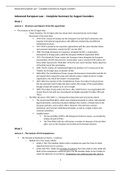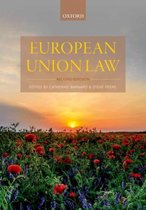Advanced European Law – Complete Summary by August Coenders
Advanced European Law – Complete Summary by August Coenders
Week 1
Lecture 1 – Structure and Nature of the EU Legal Order
The structure of the EU legal order
o Treaty Evolution: The EU legal order has always been characterised by several legal
documents at the same time
1949/1950: Council of Europe and the European Coal and Steel Community: two
separate international organisations with different membership and different
institutional structure.
1957: ECSC is joined by two separate organisations with the same Member States
and common institutions, namely the EEC and the EAEC.
1986: The Single European Act organises, alongside the EEC, a cooperation
framework for foreign policy called the European Political Cooperation (EPC).
1992: The Maastricht Treaty creates the European Union alongside the European
Communities; the EPC becomes the ‘second pillar’ and is renamed CFSP; justice and
home affairs became the ‘third pillar’ of the EU; last, some Member States opted out
of the EMU and of the social policy.
2000: The EU Charter of Fundamental Rights was drafted ‘as if’ it were part of the
Treaties, but its legal value remained in limbo.
2002-2004: The Constitutional Treaty merges the European Communities and the EU
and repeals their respective treaty and instead creates a single treaty for a single
organisation, into which the Charter is incorporated.
2007: After the rejection of the Constitutional Treaty, the Lisbon Treaty preserves
the two separate main Treaties but does confirm the merger of the organisations,
though it keeps the Charter at an ‘arm’s length’.
2009: The Lisbon Treaty enters into force, after which there is one organisation left,
namely the EU, but with two renumbered and legally equivalent Treaties (TEU and
TFEU).
o The Pillar Structure (1993-2009, i.e. introduced by Maastricht and removed by Lisbon)
The second and third pillars, which were intergovernmental in nature, had separate
legal instruments, unanimous decision-making in the Council, a limited role for the
European judiciary, and no direct effect. However, they did have common
institutions and common institutional principles, as well as a single revision and
accession procedure.
‘Depillarisation’:
The Second Pillar (CFSP) is still intergovernmental in nature, as provided by
Articles 40 and 24 TFEU.
The Third Pillar (JHA) also still retains a number of elements of the old third
pillar, such as the European Arrest Warrant Framework Decision.
Week 2
Lecture 2 – The System of EU Competences
The Principle of Attribution of Powers / Conferral:
o Spelled out in two Treaty articles:
Article 1 TEU: The Member States confer competences upon the Union to attain
objectives they have in common.
Article 5(2) TEU: “Under the principle of conferral, the Union shall act only within the
limits of the competences conferred upon it by the Member States in the Treaties to
attain the objectives et out therein. Competences not conferred upon the Union in
1
,Advanced European Law – Complete Summary by August Coenders
the Treaties remain with the Member States”. Compared with the original wording of
Article 5(1) EC (pre-Lisbon), it is striking that the second sentence has been added to
emphasise the competences of the Member States, and that the word
“competences” rather than “powers” has been used in the new wording.
o Legal basis: A specific Treaty article that defines the area, purpose, instrument and procedure
of EU actions. The choice of legal basis makes for the most frequent form of litigation, namely
disputes on the correct use of competences by the relevant actor. The Court’s doctrine here
is that, in case of doubt, the choice of legal basis must be based on the aim and content of the
legislation and on its “centre of gravity”.
o Ways of expanding EU competences:
Treaty amendments (i.e. the ‘normal’ way)
The Lisbon Treaty, in Articles 2 to 6 TFEU, created three “categories and
areas of Union competences” – though the legal basis requirement remains
a key element:
o Exclusive (Article 2(1) TFEU): “only the Union may legislate”
Bradley (2017): The mark of an exclusive competence is
that it is one which the Union is legally obliged to exercise
where Member State action would render Union action
ineffective.
o Shared (Articles 4(1-2), and 2(2) TFEU): “the States shall exercise
their competence to the extent that the Union has not”, subject to
the condition of subsidiarity
Bradley (2017): Most Union competences fall within this
category; any competence not listed as being exclusive or
ancillary is presumptively shared in character under
Article 4(1); the list provided in Article 4(2) is only that of
the principle areas of such competences.
o Complementary (Article 2(5) TFEU): “supporting, coordinating and
supplementing”, i.e. no harmonisation of any sort, but only soft
coordination and funding.
However, the delimitation of these categories is not always clear, especially
in the case of the Internal Market (see Article 114 TFEU below). There have
thus been attempts to define specific ‘no-go areas’ in the Treaties (post-
Lisbon), such as Article 4(2) TEU (national identity and security) and Article
153(5) TFEU (topics that are excluded from the EU’s social policy
competence).
Practice of the political institutions:
Paradox: This enhancing of institutional practice has been allowed by the
Council, which represents the interests of the Member States, for which
there are two possible explanations. First is the change in decision-making
over time, namely from unanimity to QMV. Second is Council members
“going native”, i.e. socialisation within the Council by which its Members
start to represent that interests of the EU rather than those of the Member
States. Important to note here is that many negotiations are not done by
the Ministers themselves but by COREPER.
The main legal basis of expansive practice are Articles 352 and 114 TFEU:
o Article 352 TFEU, a.k.a. the “flexibility clause”, allows the Council,
acting unanimously and after obtaining the consent of the EU, to
take action to attain the objectives set out in the Treaties if these
have not provided the necessary powers for the Union. However,
this is very open ended and has been used to launch entirely new
policies, though it is no longer a major source of ‘competence
2
, Advanced European Law – Complete Summary by August Coenders
creep, as new competences have been added by several Treaty
revisions.
o Article 114 TFEU allows for the approximation, i.e. harmonisation,
of laws under the OLP with the objective of “the establishment and
functioning of the internal market”. However, this poses a form of
‘competence creep’ and a possible breach of the principle of
subsidiary, as it arguably allows for harmonisation in areas of
shared competence or even of exclusive Member State
competence on the basis that such national legislation might
obstruct the functioning of the Internal Market.
Interpretation by the ECJ
The Principle of Subsidiarity (Article 5(3) TEU) asks the basic question of why a particular problem
should be dealt with by EU law rather than by national laws?
o The subsidiarity test consists of two conditions:
First, the ‘necessity test’, which asks whether the objectives of the proposed action
cannot be sufficiently achieved by the Member States.
Second, “by reason of the scale or effects of the proposed action, [the Union
objectives] be better achieved at Union level”.
o Protocol No. 2: The Early Warning Mechanism consists of two stages. First, the national
parliaments receive a draft legislative act as well as subsequent amended drafts. Next, the
national parliaments have an eight-week period in which to produce a ‘reasoned opinion’,
which is sent to the Presidents of the EP, Council and Commission. These come in three
varieties:
Opinion of individual parliaments or chambers, which the EU institutions are obliged
to “take account of”.
Collective opinions can only be adopted by at least one-third of the votes (19 out of
56), and where a number of negative votes reaches the threshold, the draft
legislation must be reviewed.
Special legislative opinions, which are opinions that may only be adopted by national
parliaments when they are examining a Commission proposal under the OLP. The
threshold for adopting such an opinion is a simple majority of the total votes
available (29); where a majority of the members of the EP or 55% of the members of
the Council reject the (amended) proposal for reasons of subsidiarity compliance, it
is dead in the water.
Bradley (2017): The Early Warning Mechanism is subject to a number of
important limitations:
o First, it only applies to legislation excluding measures adopted
by an innominate non-legislative procedure, as well as
delegated and implementing acts.
o Second, it is limited to the initial proposal and amended
versions of it; it does not allow parliaments to examine the
different preparatory acts.
o Third, even where it applies, the mechanism provides no
formal guarantee that the initiator does not press on with its
draft legislation.
o Fourth, the voting threshold for the Council to block a proposal
under the early warning mechanism is higher than the normal
threshold under the OLP.
Tutorial 2 – Challenging the Existence or Exercise of EU Competence
1. Scope of the internal market competence: data retention (Case C-301/06 Ireland v Council and Parliament)
Why did Ireland bring legal action before the Court?
3






